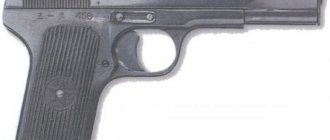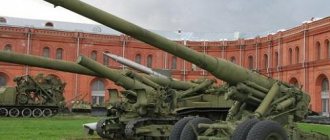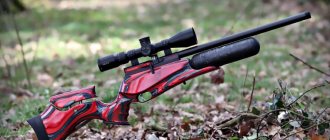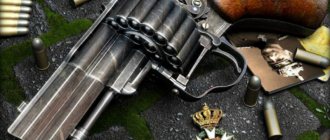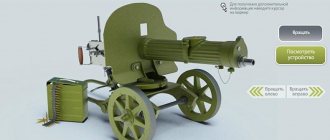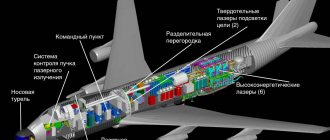In this article we will try to consider Gauss accelerators (guns), and also propose a number of actions to improve their performance.
In this process, we will not focus much on circuitry, since this issue has been discussed in sufficient detail in other works. Instead, we will focus on the areas that require effort and can significantly improve the effectiveness of these devices. In addition, we will consider alternative devices that have not yet been encountered in world practice! A Gauss gun consists of a solenoid, inside of which there is a barrel (usually made of a dielectric. A projectile made of a ferromagnet is inserted into one of the ends of the barrel. When an electric current flows in the solenoid, an electromagnetic field arises, which accelerates the projectile, “pulling” it into the solenoid. At the ends of the projectile, poles are formed, oriented according to the poles of the coil, due to which, after passing the center of the solenoid, the projectile is attracted in the opposite direction, that is, it is slowed down. In amateur circuits, a permanent magnet is sometimes used as a projectile, since the induced emf that arises it is easier to fight. The same effect occurs when using ferromagnets, but it is not so pronounced due to the fact that the projectile is easily remagnetized (coercive force).
For the greatest effect, the current pulse in the solenoid must be short-term and powerful. As a rule, to obtain such a pulse, electrolytic capacitors of large capacity and high operating voltage are used.
Often, to accelerate a projectile in the barrel, multi-stage schemes are used, in which more than 1 coil is used to accelerate the projectile.
The parameters of the accelerating coils, projectile and capacitors must be coordinated in such a way that when fired, by the time the projectile approaches the solenoid, the magnetic field induction in the solenoid is maximum, but with further approach of the projectile it drops sharply. It is worth noting that different algorithms for the operation of accelerating coils are possible.
A “traveling wave” is formed in them, i.e. the coils turn on one after another as the projectile enters them:
Image source:
The Gauss cannon as a weapon has advantages that other types of small arms do not have. This is the absence of cartridges and unlimited choice of initial speed and energy of ammunition, the possibility of a silent shot (if the speed of a sufficiently streamlined projectile does not exceed the speed of sound), including without changing the barrel and ammunition, relatively low recoil (equal to the impulse of the ejected projectile, there is no additional impulse from the powder gases or moving parts), theoretically, greater reliability and, in theory, wear resistance, as well as the ability to work in any conditions, including in outer space.
However, despite the apparent simplicity of the Gauss rifle, using it as a weapon is fraught with serious difficulties, the main one of which is high energy consumption.
The first and main difficulty
— low efficiency of the installation. Only 1-7% of the capacitor charge is converted into the kinetic energy of the projectile. This disadvantage can be partially compensated for by using a multi-stage projectile acceleration system, but in any case, the efficiency rarely reaches 27%. Basically, in amateur installations, the energy stored in the form of a magnetic field is not used in any way, but is the reason for the use of powerful switches (thyristors are often used) to open the coil.
Second difficulty
- high energy consumption (due to low efficiency).
The third difficulty (follows from the first two)
— large weight and dimensions of the installation with its low efficiency.
Fourth difficulty
- a fairly long time for accumulative recharging of capacitors, which makes it necessary to carry a power source (usually a powerful battery) along with the Gauss gun, as well as their high cost. It is theoretically possible to increase efficiency by using superconducting solenoids, but this will require a powerful cooling system, which brings additional problems and seriously affects the field of application of the installation. Or use replaceable capacitor batteries.
Fifth difficulty
— with an increase in projectile speed, the time of action of the magnetic field during the passage of the solenoid by the projectile is significantly reduced, which leads to the need not only to turn on each subsequent coil of a multi-stage system in advance, but also to increase the power of its field in proportion to the reduction of this time. Usually this drawback is immediately overlooked, since most homemade systems have either a small number of coils or insufficient bullet speed.
In addition, often the components used to build a Gauss rifle are chosen not on the basis of “optimality”, but “what was at hand”, due to the fact that “every penny counts.” This, in turn, leads to a corresponding decrease in overall efficiency.
To design a Gauss rifle, its builders usually use the well-known FEMM program and a number of scripts for it.
A number of tips and modeling options can be found here.
ATTENTION! Any work in the field of design and creation of the devices discussed carries an increased risk, and the author is not responsible for possible incidents! All information is provided only “for educational purposes” and does not call for anything!
WAYS TO IMPROVE THE GAUSS RIFLE
▍ 1. Changing the method of power switching of coils
After an analysis on the Internet, it was revealed that a large number of homemade devices are used for power switching of coils - thyristors (as mentioned above), which is an outdated approach.
And only a small number of homemade products are built on IGBT transistors. As the authors of homemade products themselves note, for the most part, this is due to their much higher price. Here it is appropriate to consider what IGBT transistors are.
Insulated gate bipolar transistor
(IGBT, English Insulated-gate bipolar transistor, IGBT) is a three-electrode power semiconductor device that combines two transistors in one semiconductor structure: bipolar (forming a power channel) and field-effect (forming a control channel).
It is used mainly as a powerful electronic switch in switching power supplies, inverters, and control systems for electric drives. Image source:
Until the 1990s, bipolar transistors were used as power semiconductor devices, in addition to thyristors. Their effectiveness was limited by several disadvantages:
- the need for a large base current to turn on;
- the presence of a current “tail”
when turning off, since the collector current does not drop instantly after the control current is removed - resistance appears in the collector circuit, and the transistor heats up (and this point is especially important for us in Gaussian construction); - dependence of parameters on temperature;
- The saturation voltage of the collector-emitter circuit limits the minimum operating voltage.
With the advent of field-effect transistors
made using MOS technology (English MOSFET), the situation has changed. Unlike bipolar ones, field-effect transistors:
- controlled not by current, but by voltage;
- their parameters do not depend so much on temperature;
- their operating voltage theoretically has no lower limit due to the use of multi-cell VLSI;
- have low channel resistance (less than a milliohm);
- can operate in a wide range of currents (from milliamps to hundreds of amperes);
- have a high switching frequency (hundreds of kilohertz or more);
- high operating voltages with large linear and load changes, heavy duty cycles and low output powers.
IGBT combines the advantages of two main types of transistors:
- high input resistance, low control power level - from field-effect transistors with insulated gate;
- low value of residual voltage in the on state - from bipolar transistors;
- low on-state losses at high currents and high voltages;
- switching characteristics and conductivity of a bipolar transistor;
- control like MOSFET - voltage.
The range of use is from tens to 1200 amperes in current, from hundreds of volts to 10 kV in voltage.
In the range of currents up to tens of amperes and voltages up to 500 V, it is advisable to use conventional MOS (MDS) transistors rather than IGBTs, since at low voltages field-effect transistors have lower resistance.
▍ 2. Increase in efficiency due to preliminary acceleration of the projectile
Preliminary acceleration of the projectile can significantly increase the efficiency. This is well said here:
The efficiency of such a thing depends radically on the output velocity of the projectile.
And it grows very, very quickly with increasing output speed. Several simple formulas (kinetic energy of a bullet, and ohmic losses during acceleration) speak about this more than unambiguously. Because the work of a magnetic field is force multiplied by displacement, and the greater the displacement, the greater the speed. So the ohmic losses per unit time remain relatively constant (it is clear that they depend on the shape of the pulse, but these are details), and the efficiency of pumping magnetic field energy into the kinetic energy of the projectile grows very quickly as the projectile accelerates, and at the same time is quadratic in speed - the energy of the projectile itself increases. In other words, if the output speed is high enough, then the lion's share of the energy will be pumped into the projectile with excellent efficiency (closer to the end of acceleration), and against this background, the ohmic losses, high as a percentage in the initial acceleration section, will be extremely insignificant in absolute value (relative to the final kinetic energy of the projectile). So for speeds of tens of m/s, the efficiency will always be .... (analogous to the word “bad” :-))) ) no matter how sophisticated you are - and since enthusiasts usually master just such energies/speeds, the efficiency “rarely exceeds 2%”. But if you accelerate to several hundred meters per second (it is better, of course, closer to large hundreds rather than small ones), then efficiency figures in the region of 70%-85% are quite reasonable. And with the added energy recovery system, you can squeeze even higher. So a well-designed Gauss cannon, coupled with well-designed projectiles, is more than capable of being a real weapon. But this is no longer a “knee-high” power level in terms of power electronics, and appropriately sized energy storage devices are required.Moreover, this “the efficiency of transferring magnetic field energy into the kinetic energy of a projectile grows very quickly as the projectile accelerates” - this is a common point for both the Gauss gun and the railgun.
For these purposes, it would be possible to use some kind of pre-acceleration system, for which we could try to use existing air rifles and pistols (loaded with a cylindrical projectile). In this case, the Gauss gun would look like an additional device at the end of the barrel of an air rifle or pistol. Something like a sound moderator for pneumatics (sometimes mistakenly called a “silencer”).
▍ 3. Use of energy recovery stored in the coil.
Since the inductor is an energy storage device, it makes some sense to “drain” it back into the supply capacitor.
This would be useful for the purpose of increasing efficiency in general. A good analysis of the feasibility of this is carried out here. And the conclusions are as follows (from the same place):
- To maximize the possibility of energy recovery inherent in the “oblique” half-bridge configuration, it is necessary to select the geometric characteristics of the coil in such a way that the current shape is close to triangular and the “plateau” corresponding to the state of the system with one open key is as short as possible. This implies the need to use different coils in each stage of a multi-stage accelerator. The use of identical coils in this case sharply reduces the possible efficiency.
- When choosing a coil geometry, the projectile acceleration efficiency should be increased rather than the recovery efficiency - this leads to an increase in the overall efficiency of the system. That is, “thick” coils, despite their increased ability to return energy to the container, are not optimal in a half-bridge circuit (at least in the region of projectile speeds of about 100 m/s).
- For the selected system characteristics, the use of a half-bridge makes it possible to increase the total efficiency of a multi-stage accelerator, probably by no more than 1.5 times compared to traditional circuits without returning part of the energy to the capacitor (for example, circuits with a damping varistor). This increase is expressed in a decrease in the total energy expended at each stage (and not in an increase in projectile speed), and can be used to correspondingly reduce the capacity of the storage capacitor.
▍ 4. Use of a complex software algorithm to control the speed of the projectile in the barrel.
As stated earlier:
“With an increase in projectile speed, the time of action of the magnetic field during the passage of the solenoid by the projectile is significantly reduced, which leads to the need not only to turn on each subsequent coil of a multi-stage system in advance, but also to increase the power of its field in proportion to the reduction of this time. Usually this drawback is immediately overlooked, since most homemade systems have either a small number of coils or insufficient bullet speed
.”
Despite a fairly thorough analysis of homemade products on the Internet, it was not possible to find a single homemade product that would use the capabilities of the present moment: namely, the use of microcontrollers to implement a complex software algorithm to control the acceleration of a projectile in the barrel.
The maximum is acceleration at pre-programmed time intervals.
This, in my opinion, is largely due to the fact that most Gauss builders follow the beaten path and try to achieve results in the shortest possible way. Therefore, they follow the path of others, not paying attention to the opportunities that are missed by many.
Namely: most homemade structures are built using optical sensors that fire the corresponding coils after their beam is interrupted by a passing projectile.
Image source:
In my opinion, this approach is quite primitive, since it allows only in very general terms to understand where the projectile is at a given moment and at what speed it is moving (or rather, in the homemade products studied, even speed analysis was not carried out, and optical sensors were used exclusively for switching coils during the passage of charge).
Although, to analyze the speed of movement of the projectile and its location, analysis of the inductance of the coil/coils is optimal (as Wikipedia tells us, “an inductance coil can be used as a displacement sensor: the change in the inductance of the coil can vary within a wide range when the ferromagnetic core moves relative to the winding”) . This will allow for constant feedback and data on the speed and location of the projectile, which, coupled with high-speed IGBT transistors, can allow the use of PWM control for optimal acceleration of the projectile.
With this approach, it is possible to provide almost any charge acceleration curve, within the available physical capabilities:
That is, one could:
- control overclocking programmatically;
- automatically calibrate and write settings to the microcontroller memory (for example, in the case of using esp32 - the Preferences library is suitable for this);
- use different acceleration curves (while using “rigidly calculated and adjusted coils” the firing parameters would always be the same).
In simpler terms, you can apply PWM control pulses to the coil, and constantly monitor at what speed the projectile began to move.
This approach will allow: a) to abandon optical sensors; b) have constant flexible feedback. For example, if the microcontroller sees that the projectile is “slowing down”, it gives it additional acceleration pulses; if it sees that it has already accelerated optimally (according to the selected speed growth curve), it turns off the power to the coil.
▍ 5. Use of spherical charges instead of oblong ones.
Since most amateurs use the Gauss gun for recreational shooting, making charges for it is quite labor-intensive and problematic for most.
In this regard, it seems quite interesting to transfer such a device to spherical steel bullets from air guns.
I saw statements from some people on the Internet who believed that it was impossible to disperse such a charge, since it would quickly become saturated, etc.
However, more recently, in 2022, an interesting device appeared on YouTube, perhaps even the only one in the world, which was able to reach speeds of 130 m per second on standard ball charges for air rifles:
Of course, the accuracy of the balls is very mediocre and is only suitable for recreational shooting at bottles - “plinking”.
The use of such charges for recreational shooting is, in my opinion, quite rational and inexpensive, in contrast to the classic “nails” on which the creativity of most Gauss builders is concentrated:
Although, it is the elongated charge that can reach long ranges, with good accuracy (as history shows). You just need to create some kind of twisting device, like in a standard firearm. In the case of the Gauss rifle, one could try to implement an electromagnetic twisting device that would provide the projectile with the necessary accuracy.
What is this anyway?
The Gauss gun consists of a solenoid, inside of which there is a barrel (tube).
A metal projectile is inserted into one end of the barrel. When an electric current flows in the solenoid, a magnetic field arises, which accelerates the projectile, “pulling” it into the solenoid. Since the current is turned off at the moment the projectile passes through the middle of the solenoid, the magnetic field will disappear and the projectile will fly out of the other end of the barrel. For the greatest effect, the current pulse in the coil must be short-term and powerful. As a rule, electric capacitors are used to obtain such a pulse. The parameters of the winding, projectile and capacitors must be coordinated in such a way that when fired, by the time the projectile approaches the middle of the winding, the current in the latter would have already decreased to a minimum value, that is, the charge of the capacitors would have already been completely consumed. In this case, the efficiency of a single-stage Gauss gun will be maximum. You can assemble the simplest single-stage Coilguns yourself, but multi-stage ones are much more difficult.
AS A HYPOTHESIS - FOR REFLECTION...
To take a break from the topic of Gauss gans, I would like to offer for discussion a couple of my ideas, analogues of which I have not seen on the Internet.
▍ 1. Internal combustion machine gun?!
What if I told you that right under your nose there is an almost ready-made device that allows you to implement high-speed shooting with a certain charge, with good accuracy and power?
The rate of fire can reach 6000 rounds per minute or more. If we look at a conventional two-stroke internal combustion engine (and, in principle, at any engine), it is a device that serves to perform useful work by extracting the necessary power from a rotating shaft. What if the power is taken not from the shaft, but directly from the cylinder?
How: a quick-acting valve is mounted in the cylinder, which opens for a short time, at the moment of combustion of the mixture, when the pressure in the cylinder is maximum (a conventional two-stroke internal combustion engine, which is used in lawn mowers or trimmers, develops a pressure of 60 atmospheres - in the cylinder, at the moment the mixture flashes).
The operating algorithm of such a valve should still be selected, for example, it can work in 2 strokes: so that one revolution of the engine shaft is used to maintain rotation, and the next revolution and, accordingly, the flash is used to select part of the high-pressure gases from the cylinder - to throw some charge.
The power take-off must be carried out in such a way and in such volumes that it allows the work of throwing a charge to be carried out, and, at the same time, does not disrupt the normal operation of the engine as such!
As such a fast-acting valve, you could try to use something similar to an electromagnetic valve, which some companies are now developing for their cars:
Thus, it turns out that there is an unlimited source of high-pressure gases, which will allow high-speed burst fire or single shots. The supply of shots, in fact, is limited only by the supply of projectile charges, since the fuel will run out much later (by the way, the charges can be supplied due to the operation of a certain feeding device driven by a rotating shaft)!
Knowledgeable people will say: “Well, that’s only 60 bar!” Even a CO2 canister has 70 bar...” It's not just about the pressure, but also about the area it affects. In a nutshell: smaller bullet – more pressure needed. More bullet means less pressure.
The following historical excursion would be appropriate here:
Girardoni air rifle.
In 1779, the Austrian mechanic Bartolomeo Girardoni (in Austria he was considered a Tyrolean, although he was Italian by origin) presented Joseph II, Archduke of Austria with a copy of a “repeat air gun,” which became perhaps the most popular military air weapon.Image source: www.drive2.ru
It would be more accurate to call this unique gun a magazine-loading breech-loading air rifle with pre-pumping. The active Archduke and members of the Military Council appreciated the idea. Considering the rate of fire of muskets of that time (3-4 rounds per minute), his sample simply plunged everyone into a state of shock with its twenty rounds per minute. Joseph the Second, calculating that 500 soldiers with such weapons would exceed the same number of flint barrels by at least five times in total firepower, ordered the rearmament of the army. However, due to the very labor-intensive technology and extremely high cost of such rifles, the army did not completely switch to new weapons, and only about 1,500 barrels were produced. Also, their initial desire to equip army rangers with a rifle was dashed by the relatively low target firing range, and the rifle (gun) was adopted by a special unit of the border guard. The Girardoni rifle had an octagonal rifled barrel of 13 mm caliber, replaceable butt-cylinder, impact metering valve and tubular magazine for 20 round bullets.
Image source:The conical cylinder was connected to the breech on a thread, the connection was sealed with a water-soaked leather cuff of the butt-cylinder. Air was pumped into the balloon with a hand pump (this required about 1,500 pumps), the pressure in it reached 33 atmospheres
, which was enough to give a 10-gram bullet an initial speed of about 200 m/s (muzzle energy - 200 J).
One cylinder was enough for 20 sufficiently lethal shots, although the ballistics, of course, changed from shot to shot - the first 10 bullets flew up to 150 steps, the next ones fell closer. The Austrian border guard riflemen used Girardoni rifles from 1790 to 1815, just during the coalition wars with France. In battles with French troops, they hit officers and artillery personnel at 100-150 steps. It is clear that such an insidious weapon irritated the French very much - Napoleon decided to give the order to shoot or hang on the spot shooters captured with an air gun in their hands.
Thus, it becomes clear that 60 atmospheres is very serious, when even 33 a...
History of creation
This type of rifle first appeared in the first part of “Stalker,” which was called “Shadow of Chernobyl.” At the penultimate location “Pripyat” the player was met by multiple enemy forces, they were everywhere, even on the roofs of abandoned houses, from which they fired at us with Gauss. The rifle itself is incredibly rare, and if you didn’t kill the Monolith correctly, then we can safely say that you won’t touch it again in the game. There is also a chance that the corpse of this fighter will fall, but there will be no cartridges for the rifle at all. All this is due to the fact that the development of the first part was carried out in incredible haste, many types of weapons were cut out, not to mention locations, cars and much more.
If we talk about mentions of this rifle, then in the “Dark Valley” location, right opposite the bandits’ base, we could save a stalker from a bloodsucker, for which he thanks us with the information, they say, on a pig farm they sell a Gauss gun for only 800 rubles. We go there, give the stalkers 800 rubles, which at the very beginning of the game can change a lot, but in return they give us nothing, and even more: we are kicked out of the territory of the pig farm, because... They don’t have any Gauss rifle, and this money will go to charity. After this, you can calmly kill them, and the “Ghoul” stalker will drop a special “Viper” silent rifle.
This all happened in the first part, but now in the second, whose name is “Clear Sky”, you can quite easily find this rifle. The right to purchase it is given to players whose actions are impeccable (statistics can be viewed in the PDA), after which every merchant will happily sell you Gauss and the first generation exoskeleton.
“Call of Pripyat” tried to be as similar as possible to the first part, which, in fact, happened, because in this part the rifle is taken again from the roof and again from the corpse of a fallen “Monolith” soldier. After picking it up, a special quest is activated, which we will talk about a little later.
Where can you use an electric heat gun?
Since electric heat guns do not produce harmful combustion products and, subject to operating conditions, are fireproof, they can be used to service almost any facility.
Electric heat guns can be used to heat unheated residential buildings, country houses, garages, workshops, and greenhouses. Heat guns are considered one of the most effective ways to heat “complex” objects - very large in area, very frozen. They are purchased for servicing workshops of industrial enterprises, warehouses, retail facilities, industrial premises, hangars, construction sites (including open ones).
A heat gun is often used when you need to heat a room, any physical objects or surfaces as quickly as possible. In construction, electric heat guns are actively used for drying plastered surfaces and when installing suspended ceilings. In everyday life, there may be a need to quickly warm up a car or dry out a cellar; an electric heat gun is also suitable for these purposes. Guns are also used in industry to perform certain technological operations.
Gauss Gun on AliExpress
Two-stage Gauss gun
- Copper enameled winding wires with a diameter of 0.8 mm
- Two SCR type thyristors
- Optical switch block
- 450V 1000uF capacitors installed
- Tubes with a diameter of 8 mm and a length of 200 mm
- Price about 1000 rubles.
Four stage Gauss gun
- The outer diameter of the tube is 10 mm and the inner diameter is 8 mm
- Need 12V lithium battery and 70W power supply
- Full set of voltage control, charging and discharging, lithium battery and built-in charger.
- Price about 10,000 rubles.
Multi-stage Gauss gun
- The most powerful specimens, having 6 stages and accelerating a metal projectile to the maximum energy permitted by law of 7 J.
- The total capacity of storage capacitors can exceed 10,000 microfarads.
- Price about 12,000 rubles.
Warning! The device is prohibited for sale or use by persons under 16 years of age, for adults only. You cannot shoot at people or animals. Do not touch circuit elements - high voltage.
Heater maintenance and repair
During long-term operation of the gun, minor malfunctions arise that the user can eliminate with his own hands. Symptoms of problems and repair methods:
- After turning on the device starts, but quickly goes out. Remove the flame photosensor from the socket and remove the soot from the working lens.
- If the heating intensity decreases, clean the air and fuel filters. The manufacturer recommends changing filter elements at intervals of 500 operating hours.
- Ignition of the air-fuel mixture is difficult or absent. Unscrew the spark plug, remove the soot and adjust the gap between the electrodes (usually set to 1.4...1.5 mm).
- A decrease in efficiency and the appearance of black smoke indicates a clogged injector. In most models, the part can be easily removed and cleaned; if you can’t handle it, call a professional.
- Another reason for difficult starting is problems with the compressor. The unit should be cleaned and the operating pressure adjusted, and if necessary, lubricate the electric motor.
Scheme of fastening the spark plug and nozzle in the burner of the Master apparatus.
The glow plug and nozzle are located on the rear plane of the head of the burner device. There are 2 tubes connected to the sprayer (air from the compressor and fuel supply), and a high-voltage cable to the igniter. The latter often hits ground, causing the spark to disappear from the spark plug.
The fuel strainer is located inside the supply tube, lowered into the tank. By the way, the container also needs to be washed every 500 hours of operation. The air purification elements are located on the rear panel of the compressor and are unscrewed with a screwdriver. How to clean a heat gun nozzle, watch the video:
Operating principle
The Gauss gun consists of a solenoid, inside of which there is a barrel (usually made of dielectric). A projectile made of a ferromagnetic material is inserted into one end of the barrel. When an electric current flows in the solenoid, an electromagnetic field arises, which accelerates the projectile, “pulling” it into the solenoid. In this case, poles are formed at the ends of the projectile, oriented according to the poles of the coil, due to which, after passing the center of the solenoid, the projectile is attracted in the opposite direction, that is, it is slowed down. In amateur circuits, a permanent magnet is sometimes used as a projectile, since it is easier to combat the induced emf that arises. The same effect occurs when using ferromagnets, but it is not so pronounced due to the fact that the projectile is easily remagnetized (coercive force).
For the greatest effect, the current pulse in the solenoid must be short-term and powerful. As a rule, to obtain such a pulse, electrolytic capacitors of large capacity and high operating voltage are used.
The parameters of the accelerating coils, projectile and capacitors must be coordinated in such a way that when a shot is fired, by the time the projectile approaches the solenoid, the magnetic field induction in the solenoid is maximum, but with further approach of the projectile it drops sharply. It is worth noting that different algorithms for the operation of accelerating coils are possible.
Kinetic energy of the projectileE=mv22{displaystyle E={mv^{2} over 2}} m{displaystyle m} - mass of the projectilev{displaystyle v} - its speedEnergy stored in the capacitorE=CU22{displaystyle E={CU^{2} over 2}} U{displaystyle U} - capacitor voltage C{displaystyle C} - capacitor capacityCapacitor discharge time
This is the time during which the capacitor is completely discharged:
T=πLC2{displaystyle T={pi {sqrt {LC}} over 2}} L{displaystyle L} - inductance C{displaystyle C} - capacitanceInductor operating time
This is the time during which the EMF of the inductor increases to its maximum value (full discharge of the capacitor) and completely drops to 0. It is equal to the upper half-cycle of the sine wave.
T=πLC{displaystyle T=pi {sqrt {LC}}} L{displaystyle L} - inductance C{displaystyle C} - capacitance
It is worth noting that, in their presented form, the last two formulas cannot be used to calculate a Gauss gun, if only for the reason that as the projectile moves inside the coil, its inductance changes all the time.
Railgun - the weapon of the future
Railgun, or in common parlance “rail”, is a pulsed electrode mass accelerator, the principle of operation of which is explained using the Lorentz force, which converts electrical energy into kinetic energy. It is a promising weapon that has a number of advantages over the classical design based on a chemical explosion. And the combat trials of this beauty are just around the corner.
Operating principle and limitations
A rail gun uses an electromagnetic force called the Lorentz force to accelerate an electrically conductive projectile that is initially part of a circuit. Sometimes movable reinforcement is used to connect the rails. A current I passing through the rails excites a magnetic field B between them, perpendicular to the current passing through the projectile and the adjacent rail. As a result, mutual repulsion of the rails occurs and the projectile accelerates under the influence of force F.
One of the problems with the railgun is that to make its projectiles, a material with the highest possible conductivity is needed, because To create a driving force, a very powerful instantaneous discharge of current is released along the rails. If the projectile material is not sufficiently conductive, it may be vaporized in the railgun by the current before leaving the gun. The second limiter is the power supply. In the near future, the US Navy plans to test a railgun on a ship base (only a ship today can withstand a shot from this weapon). A salvo from a modern railgun requires an impulse of 25 (!) megawatts. One of the US Navy ships, which was designed specifically to be equipped with a railgun, is equipped with power plants of 78 megawatts, and the most common value of el. The installation power on the ship is 9 megawatts. For one shot of a railgun, almost 30% of the power of the special installation is required. fleet ship. You shouldn’t even think about using this type of weapon on ordinary ships. Video from the US Navy experimental installation: Question for the audience: where did the fiery flash at the exit come from?

